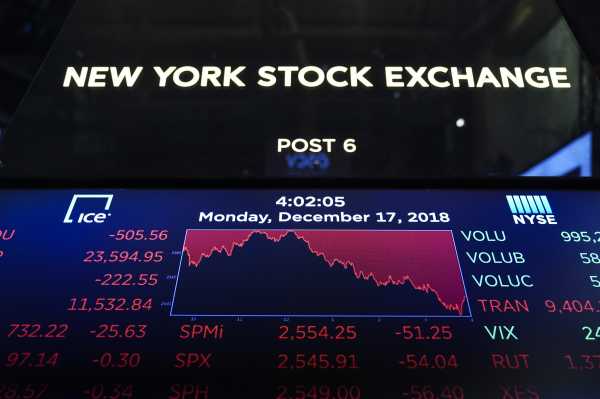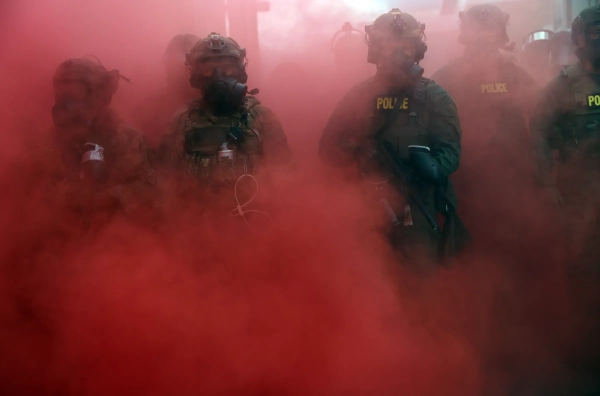
The stock market isn’t looking so hot these days.
After years of an upward trajectory in the wake of the financial crisis, Wall Street has become unpredictable again. The S&P 500, the Dow Jones Industrial Average, and Nasdaq are all well in the red for the year, and the stock market is potentially on track for its worst December since the Great Depression. Multiple market measures indicate an economic slowdown could be on the horizon, and many market experts and observers are starting to sound the alarm. President Donald Trump, who was once happy to tie his success to the stock market, has gone quiet on the matter except to try to cajole the Federal Reserve.
Former Fed Chair Alan Greenspan said in an interview with CNN aired Tuesday that it would be a “surprise” to see the market stabilize here and take off, but even if it did, the outlook would be bleak. “At the end of that run, run for cover,” he said.
So what’s going on? There’s never any one reason why markets move or investors suddenly become extra fearful or optimistic. What’s happening now is that a confluence of factors are causing anxiety on Wall Street, and it’s starting to look like the post-crisis party might be coming to an end.
“The financial markets as a whole give you a very bleak message,” Jim Paulsen, the chief investment strategist at the investment research firm the Leuthold Group, told me.
What goes up must come down, and that might finally be happening now
The current economic expansion and stock market run (until recently) has been going on for so long — and so much longer than many economists expected — that investors have been wondering for quite some time when that luck would run out. It looks like a combination of global and domestic events are starting to convince Wall Street that time is now.
Trump’s trade war with China is causing a variety of concerns, ranging from its impact on US farmers to its potential to raise consumer prices to its economic effects in both China and the US. Economic growth has slowed in Europe and is expected to slow in China next year. Drama over Brexit is also causing ripples, as are signals from the US Fed that it will continue to hike interest rates, potentially dampening the stock market and economy.
“All year, there’s been this nonstop search for the thing that would bring this cycle to an end,” Nick Colas, the co-founder of the market insight firm Datatrek Research, told me. “For a while, the market was able to shrug it off, but the last couple of months have made people feel like, yeah, this is the end.”
In the US, the fiscal stimulus from the Republican tax bill, combined with a boost in government spending, is likely going to soon run out. The Congressional Budget Office estimates that GDP growth will be 3.1 percent in 2018 and decline to 2.4 percent in 2019. It then expects GDP growth will slow to 1.6 percent each year from 2020 through 2022 and 1.7 percent annually from 2023 to 2028.
“Maybe this is the realization that growth going forward is no longer going to be accelerating and that the US economy in particular is going to be facing a more restrained global backdrop going into 2019,” Greg Daco, an economist at the forecasting and analysis firm Oxford Economics, said.
The market is freaking itself out even more by freaking out
The stock market has become volatile since about October, when whatever oncoming anxieties traders feel had begun to set in. Since then, the tumult has kept up, perhaps in part because this has turned into a sort of self-fulfilling prophecy: Something goes wrong, analysts and pundits start saying the end is nigh, and that makes the hysteria even greater.
“Once you get spooked by something, you start being very sensitive to other bumps in the night,” Colas said.
And there are a lot of bumps.
Goldman Sachs, in a note to clients last Friday, warned that it might be time for investors to get defensive. On Tuesday, Credit Suisse slashed its expectations for the S&P 500 in 2019, citing “recent volatility.”
Market observers have begun to point to so-called “death crosses,” which are basically stock charts that are supposed to indicate a selloff is coming. The death cross takes place when a short-term trend tracker on a stock or index, generally its 50-day moving average, crosses below its 200-day moving average, a longer-term trend.
And then there’s the “yield curve,” which sounds wonky but is important because there is evidence that it’s often a sign of what’s to come. As Robert Samuelson at the Washington Post explains, the yield curve refers to the relationship between short-term and long-term interest rates, generally on Treasury notes. Normally, long-term interest rates are higher than short-term rates, because it’s riskier for investors to lend money for longer periods of time. When short-term rates get higher than long-term rates, the yield curve becomes “inverted,” and that’s often a bad indicator. Every US recession for the past 60 years was preceded by an inverted yield curve.
The yield curve isn’t inverted now, but it has flattened. “The first step to inversion is flat,” Colas said, “and no one wants to wait around for it to invert.”
Trump kind of has a point about the Fed
President Trump has been increasing his criticism of the Fed in recent months and urging it to keep interest rates down. This week, he’s fired off a pair of tweets discouraging the Fed from raising interest rates on Wednesday, as is widely expected.
Trump isn’t wrong that the Fed runs a risk in getting too aggressive on interest rates. The infamous saying about the Fed is that its job is to “take away the punch bowl as the party gets going” — meaning cool down the economy before it heats up too much — but it’s not clear that we’re actually there yet. Inflation is about in line with the Fed’s goal of 2 percent, economic growth isn’t out of control, and the labor market is strong, but not perfect.
Investors will be looking at not only what the Fed does on interest rates this week but also what it says about its future plans — will it keep the pace of gradually raising rates it’s been on since December 2015, or will it slow down a bit?
“The overarching theme and question of 2019 is how does the Fed manage a soft landing on the economy?” Daco said.
There’s a tension between competing concerns that growth will slow but that inflation will take off — Greenspan warned that the US could be headed to a period of “stagflation.” Paulsen agreed. “You’ve got a stagflation mindset, and that really limits the path for the bull market,” he said.
Relax
Turmoil in the stock market can put anyone on edge, but here’s the thing: Stock market swings and corrections happen, and on average, there are more up years than down years. From 1926 to 2017, the S&P 500 delivered positive returns three-quarters of the time. In positive years, it was up an average of 21 percent, and in the bad years, it was down 14 percent.
The stock market has been on a really good run for a while — there was literally a Bloomberg headline at the start of the year declaring that “the stock market never goes down anymore.” It’s up to individual investors whether they want to stay invested or ride out the current turmoil, but this isn’t a meltdown of the global economy.
If this downward trend continues, this will also be the first time many millennials are experiencing a stock market downturn since they’ve had a stake in the game. This is the first time anyone under the age of 30 has seen a downturn in their adult savings life, and if they didn’t get a 401(k) until they were 25 or so, that’s anyone under the age of 35.
This isn’t ideal, but it’s not the end of the world, either.
“Over the long term, the market has many more up years than down years,” Colas said. “It’s just the down years suck.”
Sourse: vox.com






